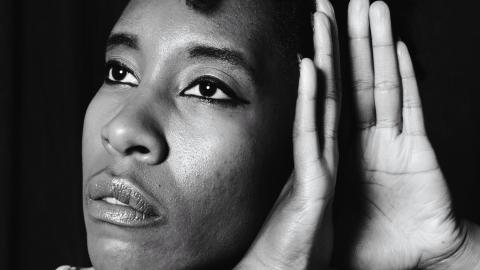
Note: Juliette Sterkens and David Myers led a Hearing Loop Workshop which can be found on youtube.com/@disabilityconcerns.
When my audiology practice started introducing and popularizing hearing loop technology in Oshkosh, WI, many people thought they were seeing the latest hearing technology. In reality, the idea had been around for more than half a century. I had learned about hearing loops back in the late-70s while studying the benefits of a variety of public assistive listening systems in my birth country, the Netherlands. Assistive listening systems help overcome hearing aid shortcomings, much like ramps overcome wheelchair limitations.
Assistive listening systems, an accommodation in public places where PA systems are in use, are mandated by the Americans with Disabilities Act. (Although worship places are exempt from the ADA mandate, most seek to offer hearing accessibility.) Unlike systems that require the user to pick up a headset and receiver, a hearing loop system is inconspicuous: it broadcasts a silent, electromagnetic signal into the telecoil of the hearing aid. The telecoil (or T-coil) is a low- or no-cost common feature in most hearing aids and all cochlear implants, which are programmed for the user’s individual hearing loss. Once the user activates a telecoil, usually at the touch of a button on the instrument, the hearing aid receives the hearing loop magnetic signal.
While loops are common in the United Kingdom and Northern Europe, in the United States these systems were late to arrive. In the U.S., FM and infrared systems tended to be the go-to technology—until Dr. David Myers began his loop advocacy in the early 2000s. Since then, thanks to an army of hearing loss advocates and loop users, the adoption of loops has increased dramatically, not only in the state of Michigan but in many areas of the U.S.
I heard Dr. Myers speak in 2008 on the success of the Holland, MI, hearing loop initiative. The benefits spoke to me: 1) users hear clear audio, free of background noise, streamed directly into their hearing aid without needing to use a separate listening device with a hearing aid-incompatible headset, and 2) venues do not need to maintain, sanitize, hand out, and manage listening devices. Sitting in that presentation, I realized how beneficial loops could be for my hearing aid using patients. For years, clients had voiced universal complaints: “I can hear OK when it’s quiet, doc, but not when I am in noise or in church!”
So I set out to foster hearing loop installations in Oshkosh, WI, with the help of my retired engineer husband, who was soon followed by a number of audi-visual companies that saw a business opportunity. I educated clients and reached out to hearing care providers, first in the Fox Valley area, and soon, in the whole state. Articles in local newspapers (here and here) helped spread the word. Every installed hearing loop seemed to increase the momentum of the “hearing loop movement” as more users admitted that they previously heard little or nothing in theaters or their places of worship. Some in the ministry became advocates themselves.
Today, more than 840 places in Wisconsin, including close to 500 churches, have installed loops, and loop installers continue to be busy with site visits and installations. Several independent studies1,2 have confirmed that hearing aid users greatly benefit from having access to a telecoil and loop systems. The good news is that telecoils, found in nearly all cochlear implants, are increasingly found in consumer preferred, cosmetically appealing, small hearing aids.
Why should places of worship install a hearing loop? Hasn’t Bluetooth (BT) technology evolved to the point that it can provide public assistive listening?
The short answer is no. Not yet. Standard Bluetooth technology is based on one-on-one transmission, while public assistive listening systems require one-to-all transmission. Such systems frequently must cover relatively large areas (think cathedrals or theaters) and often distances are well beyond the roughly 30-foot transmission limit of current Bluetooth technology. While some hearing aids claim to be Bluetooth compatible, they require an intermediary device (e.g., a smartphone or dedicated receiver ) to process the signal. These intermediary devices, if they even work over large distances, will introduce significant audio-delay in the sound that is perceived by the user.
A quick Google search will lead to websites of several audio equipment companies touting that it is time to “replace clunky, maintenance-intensive, unhygienic assistive listening devices with smartphones, and eliminate messy wiring.” Their web-based articles suggest that an audio-over-wifi system is simple to install, less costly, and makes audio broadcast to BT-enabled hearing aids and smartphones easy. Is handling a smartphone in this type of situation easy for the typical hearing aid user? Having read thousands of social media comments by hearing professionals on their clients’ inability to handle and download apps, or link and pair to networks, I conclude not.
So, with limited funds and asked to do due diligence, what is a church AV person to do?
He or she should consider both the latency (audio delay) that an intermediary device introduces and the needs of the people for whom assistive listening systems are being installed.
Audio-via-wifi “assistive systems” have their place in venues where 1) audio translation is needed, or 2) audio is silenced, and 3) every guest walks in with a smartphone in their pocket (like sports bars or fitness clubs.) But they do not provide effective, easy to use, assistive listening for people who use prescribed hearing aids and cochlear implants and who cannot make do with a smartphone or generic receiver that doesn’t compensate for their hearing loss. While a lip-sync issue for an hour of fitness or an occasional glance at a sports broadcast on a TV monitor in a bar isn’t bothersome, it wreaks havoc with the precarious speech understanding of hearing aid users in places with live audio.
In audio-via-wifi systems, hearing aid users have reported hearing echoes and seeing dramatic lip-sync delays. It is easy to understand why this happens. Many hearing aid users need to hear a mix of 1) direct audio (coming from a hearing aid microphone in order to hear their voice or someone sitting beside them) and 2) the assistive audio from a hearing loop. The latency between these two signals should not exceed 50 msec and preferably should be less than 40 msec (as per IEC TR63079), according to audio and assistive listening expert Peter Mapp.3
Furthermore, providers of these audio-via-wifi systems have yet to submit credible evidence from independent researchers that their systems actually benefit people with hearing loss. To the contrary, many consumers with hearing loss have complained that decisions about assistive listening are made without their input and have resulted in these systems not being utilized. Often these unsatisfactory systems get replaced by a hearing loop.
If not an audio-via-wifi system, what about a newer Bluetooth Low Energy Audio (BTLE) technology called Auracast that is on the horizon?
BTLE is currently being developed, and it will enable audio transmission of one-to-many and over considerably greater distances, and purportedly with low latency. Here at last, according to Peter Mapp, there might be a replacement for hearing loops. However, implementation of this technology is still years away. Some hearing industry experts expect it will be a decade or longer before a newer BTLE technology gets the bugs worked out and becomes established.
These systems will also have to be adapted for use with most hearing aids on the market, which will require studies with large groups of (international) hearing aid users. This transition will also be hampered by acceptance of BTLE into building and code of practice standards (some which have taken years to be written up in current formats), as well as the typical lifecycle of hearing aids and cochlear implants (5-15 years). In the meantime, facilities must install an acceptable assistive listening system for today’s users. While it is anticipated that BTLE will eventually become the standard digital assistive listening system, hearing loops will co-exist with BTLE for years to come.
How to obtain a quality hearing loop in your facility?
It is important to work only with a trained and experienced installer, one who will install the hearing loop to meet the International Hearing Loop Standard (IEC 60118-4) and ensure the loop meets the needs of your hard of hearing parishioners. For detailed information on how to purchase a hearing loop, see this guide. Make sure that those who provide the audio input or use the microphones have a basic understanding that only direct audio input or words spoken into the microphone—with little or no ambient sound—should be broadcast over the hearing loop. The loop performance depends on clear inputs. The output of the hearing loop should be occasionally monitored by persons responsible for the audio system. If it sounds clear to the listener, it will sound GREAT to users with T-coil equipped hearing aids.
How can churches get the most from their hearing loop?
To make parishioners and visitors aware, install clear and easily visible signage, both inside and outside the sanctuary. Include the technology in your housekeeping announcements, such as, “Our facility offers a hearing loop for users of hearing aids with telecoils.” Add a brief reminder in the bulletin and consider an annual bulletin insert on loop benefits.
Information should also be published on the church website, and an occasional post on social media will benefit members and their loved ones. Most churches offer a few loop listening devices with headsets for those without hearing aids, so be sure to keep them in a visible place. An annual sermon on Matthew 11:15 (“Whoever has ears, let them hear”) and the loop—while holding up a loop listener headset—can re-invite parishioners to give a headset device a try.
Everyone deserves to hear well.
Dr. Juliette Sterkens is an audiologist and assistive technology practitioner in Oshkosh, WI. She serves as the national hearing loop advocate for the Hearing Loss Association of America.
- https://hearingreview.com/hearing-products/testing-equipment/effects-hearing-loop-systems-speech-understanding-sound-quality-normal-hearing-listeners-hearing-aid-users
- https://hearingreview.com/hearing-products/implants-bone-conduction/cochlear-implants/consumer-perceptions-impact-inductively-looped-venues-utility-hearing-devices
- www.soundandcommunications.com/sound-communications-september-2021-digital-edition/
- Andrew Bellavia in the “Wireless Hearing” HearingTracker podcast

Let's Discuss
We love your comments! Thank you for helping us uphold the Community Guidelines to make this an encouraging and respectful community for everyone.